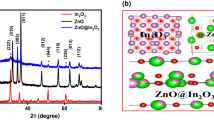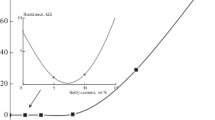Abstract
TiO2/SnO2 nanocomposites are studied as potential candidates for gas sensors. Commercial metal oxide nanopowders milled for 1 h in ethanol are used for preparing nanocomposites with varied composition from 100 mol% TiO2 to 100 mol% SnO2. Brunauer–Emmett–Teller (BET) adsorption isotherms served to determine specific surface area, SSA. The particle size distribution is established by means of Dynamic Light Scattering, DLS technique. Differential Thermal Analysis and Thermogravimetry, DTA/TG measurements within the temperature range of 20–900 °C indicate better stability of nanomaterials composed of bigger particles or agglomerates. The total mass loss varies from 0.9 to 8.5% for 100 mol% SnO2 and 100 mol% TiO2, respectively. The only gaseous products of decomposition are water and carbon dioxide. X-ray diffraction analysis of nanocomposites indicates two separate phases of different crystallite size, i.e., smaller rutile TiO2 (9 nm) and larger cassiterite SnO2 (28 nm). Gas sensor dynamic responses at 400 °C to the reducing gas—ammonia (NH3) are detected in the concentration range extending from 100 ppm to −5000 ppm. Nanosensor of 50 mol% SnO2/50 mol% TiO2 is stable and sensitive to the interaction with NH3 and gives the highest response at 400 °C.







Similar content being viewed by others
References
Yamazoe N. New approaches for improving semiconductor gas sensors. Sens Actuators B. 1991;5:7–19.
Di Francia G, Alfano B, La Ferrara V. Conductometric gas sensors. Hindawi Publishing Corporation, Journal of Sensors, 2009. doi:10.1155/2009/659275.
Timmer B, Olthuis W, van den Berg A. Ammonia sensors and their applications—a review. Sens Actuators B. 2005;107:666–77.
Ivanov P, Hubalek J, Malysz K, Prášek J, Vilanowa X, Llobet E, Correig X. A route toward more selective and less humidity sensitive screen-printed SnO2 and WO3 gas sensitive layers. Sens Actuators B. 2004;100:221–7.
Shimizu Y, Okamoto T, Takao Y, Egashira M. Desorption behavior of ammonia from TiO2-based specimens—ammonia sensing mechanism of double-layer sensors with TiO2-based catalyst layers. J Mol Catal A Chem. 2000;155:183–91.
Zhang W, Zhang W. Fabrication of SnO2–ZnO nanocomposite sensor for selective sensing of trimethylamine and the freshness of fish. Sens Actuators B. 2008;134:403–8.
Yu JH, Choi GM. Electrical and CO gas sensing properties of ZnO–SnO2 composites. Sens Actuators B. 1998;52:251–6.
Khorami HA, Keyanpour-Rad M, Vaezi MR. Synthesis of SnO2/ZnO composite nanofiber by electrospinning method and study of its ethanol sensing properties. Appl Surf Sci. 2011;257:7988–92.
Tang H, Yan M, Zhang H, Li S, Ma X, Wang M, Yang D. A selective NH3 gas sensor based of Fe2O3–ZnO nanocomposites at room temperature. Sens Actuators B. 2006;114:910–5.
Kotsikau D, Ivanovskaya M, Orlik D, Falasconi H. Gas-sensitive properties of thin and thick film sensors based on Fe2O3–SnO2 nanocomposites. Sens Actuators B. 2004;101:199–206.
Rumyantseva M, Kovalenko V, Gaskov A, Makshina E, Yuschenko V, Ivanova I, Ponzoni A, Faglia G, Comini E. Nanocomposites SnO2/Fe2O3: sensor and catalytic properties. Sens Actuators B. 2006;118:208–14.
Shouli B, Dianqing L, Dongmei H, Ruixian L, Aifan C, Liu CC. Preparation, characterization of WO3–SnO2 nanocomposites and their sensing properties for NO2. Sens Actuators B. 2010;150:749–55.
Moon WJ, Yu JH, Choi GM. Selective gas detection of SnO2–TiO2 gas sensors. J Electron. 2004;13:707–13.
Aifan C, Shouli B, Bingjie S, Zhiyong L, Dianging L, Liu CC. Methane gas-sensing and catalytic oxidation activity of SnO2–In2O3 nanocomposites incorporating TiO2. Sens Actuators B. 2008;135:7–12.
Shouli B, Liangyuan C, Pengcheng Y, Ruixian L, Aifan C, Liu CC. Sn/In/Ti nanocomposite sensor for CH4 detection. Sens Actuators B. 2008;135:1–6.
Radecka M, Zakrzewska K, Rekas M. SnO2–TiO2 solid solutions for gas sensors. Sens Actuators B. 1998;47:193–9.
Carotta MC, Gherardi S, Guidi V, Malagu C, Martinelli G, Vendemiati B, Sacerdoti M, Ghiotti G, Morandi S, Bismuto A, Maddalena P, Setaro A. (Ti, Sn)O2 binary solid solutions for gas sensing: spectroscopic, optical and transport properties. Sens Actuators B. 2008;130:38–45.
Carotta MC, Gherardi S, Guidi V, Malagu C, Martinelli G, Vendemiati B, Sacerdoti M. Electrical and spectroscopic properties of Ti0.2Sn0.8 solid solution for gas sensing. Thin Solid Films. 2009;517:6176–83.
Zeng W, Liu T, Wang Z. Sensitivity improvement of TiO2-doped SnO2 to volatile organic compounds. Phys E. 2010;43:633–8.
Zakrzewska K, Radecka M. TiO2–SnO2 system for gas sensing—photodegradation of organic contaminants. Thin Solid Films. 2007;515:8332–8.
Madarász J, Brăileanu A, Crişan M, Răileanu M, Pokol G. Evolved gas analysis of amorphous precursors for S-doped TiO2 by TG-FTIR and TG/DTA-MS. J Therm Anal Calorim. 2009;97:265–71.
Sergent N, Gélin P, Périer-Camby L, Praliaud H, Thomas G. Study of the interactions between carbon monoxide and high specific surface area tin dioxide. Thermogravimetric analysis and FTIR spectroscopy. J Therm Anal Calorim. 2003;72:1117–26.
Pulisova P, Bohacek J, Subrt J, Szatmary L, Bezdicka P, Vecernıkova E, Balek V. Thermal behaviour of titanium dioxide nanoparticles prepared by precipitation from aqueous solutions. J Therm Anal Calorim. 2010;101:607–13.
Crisan M, Braileanu A, Crisan D, Raileanu M, Dragan N, Mardare D, Teodorescu V, Ianculescu A, Birjega R, Dumitru M. Thermal behaviour study of some sol-gel TiO2 based materials. J Therm Anal Calorim. 2008;1:7–13.
Banerjee S, Kumar A, Sujatha Devi P. Preparation of nanoparticles of oxides by the citrate-nitrate process. Effect of metal ions on the thermal decomposition characteristics. J Therm Anal Calorim. 2011;104:859–67.
Acknowledgment
This work was supported by the Polish Ministry of Science and Higher Education (2009–2012) grant no. N N507 466537.
Author information
Authors and Affiliations
Corresponding author
Rights and permissions
About this article
Cite this article
Radecka, M., Kusior, A., Lacz, A. et al. Nanocrystalline TiO2/SnO2 composites for gas sensors. J Therm Anal Calorim 108, 1079–1084 (2012). https://doi.org/10.1007/s10973-011-1966-y
Published:
Issue Date:
DOI: https://doi.org/10.1007/s10973-011-1966-y




